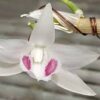# Dendrobium Orchids: The Art and Science of Creating New Hybrids Through Crossbreeding

Dendrobium orchids, particularly the *Dendrobium nobile* and its hybrids, are among the most popular and sought-after orchids in the world. Renowned for their vibrant colors, exquisite shapes, and fragrant blooms, these orchids have captivated the hearts of horticulturists and enthusiasts alike. One of the most exciting aspects of Dendrobium orchids is the creation of new hybrids through crossbreeding. This article delves into the intricacies of hybridization, exploring the methods, benefits, and challenges associated with developing new Dendrobium orchid varieties.
## 1. Understanding Dendrobium Orchids
### 1.1 Overview of Dendrobium Species
Dendrobium orchids belong to the Orchidaceae family, which boasts a diverse range of species and hybrids. *Dendrobium nobile* is the most common species cultivated for its spectacular blooms and ease of care. This species is native to Southeast Asia and is characterized by its cane-like pseudobulbs, elongated leaves, and fragrant flowers that bloom in a variety of colors, including white, yellow, pink, and purple.
### 1.2 Importance of Hybridization
Hybridization plays a crucial role in the development of new Dendrobium orchid varieties. By crossing different species and cultivars, growers can introduce desirable traits such as improved flower colors, increased size, enhanced fragrance, and greater resilience to diseases. The process of hybridization not only expands the aesthetic appeal of orchids but also contributes to the conservation of genetic diversity within the species.
## 2. The Basics of Hybridization
### 2.1 What is Hybridization?
Hybridization is the process of crossing two different plant varieties or species to create offspring that possess traits from both parents. In orchids, hybridization can occur naturally in the wild or be facilitated by horticulturists in controlled environments.
### 2.2 Types of Hybridization
There are two primary types of hybridization in orchids:
– **Intergeneric Hybridization**: This occurs between two different genera of orchids. While rare, it can result in unique hybrids with distinct characteristics.
– **Interspecific Hybridization**: This involves crossing two different species within the same genus, which is the most common method used for developing new Dendrobium hybrids.
### 2.3 The Hybridization Process
The hybridization process involves several key steps:
1. **Selection of Parent Plants**: Growers select parent plants based on their desirable traits. For Dendrobium orchids, this may include flower color, size, shape, and growth habits.
2. **Pollination**: The pollination process involves transferring pollen from the anther (male reproductive part) of one parent plant to the stigma (female reproductive part) of the other. This can be done manually using a fine brush or by using a sterile tool.
3. **Seed Development**: After successful pollination, the ovary of the flower develops into a seed pod. It typically takes several months for the seed pod to mature and develop seeds.
4. **Seed Germination**: Dendrobium orchid seeds are extremely small and require specific conditions for germination. They are usually germinated in sterile culture media in a controlled environment, as they lack the necessary nutrients to sprout on their own.
5. **Seedling Cultivation**: Once the seeds germinate, the seedlings are nurtured in sterile conditions until they develop sufficient roots and leaves. They are then gradually acclimatized to normal growing conditions.
6. **Maturation**: The young orchids continue to grow and develop, and after a period of time, they may produce flowers. It can take anywhere from one to several years for hybrids to bloom for the first time.
## 3. Selecting Parent Plants for Hybridization
### 3.1 Criteria for Selection
The selection of parent plants is critical to the success of hybridization. Growers typically consider the following criteria:
– **Flower Characteristics**: Color, shape, size, and fragrance are key traits that growers may want to enhance in the new hybrid.
– **Plant Vigor**: Parent plants should exhibit healthy growth habits, strong root systems, and resistance to diseases.
– **Genetic Compatibility**: Not all species can be successfully crossed. Growers must understand the genetic relationships between potential parent plants.
### 3.2 Notable Parent Plants for Dendrobium Hybrids
Some popular parent plants used in Dendrobium hybridization include:
– **Dendrobium nobile**: Known for its fragrant flowers and vibrant colors, this species is a foundational parent in many hybrids.
– **Dendrobium phalaenopsis**: This species is prized for its large, flat flowers that resemble moths, and it adds unique traits to hybrids.
– **Dendrobium kingianum**: Known for its compact growth and beautiful blooms, this species is often crossed to produce smaller, more manageable hybrids.
## 4. The Role of Technology in Hybridization
### 4.1 Advances in Plant Breeding Techniques
Recent technological advancements have revolutionized the way orchid hybridization is approached. Techniques such as molecular markers, tissue culture, and genetic analysis provide valuable tools for orchid breeders.
### 4.2 Molecular Marker Technology
Molecular markers are DNA sequences that can be used to identify specific traits in plants. This technology allows growers to select parent plants with desirable genetic characteristics more efficiently.
– **Trait Mapping**: By mapping specific traits to particular genes, breeders can make informed decisions when selecting parent plants for hybridization.
### 4.3 Tissue Culture Techniques
Tissue culture has become an essential method for propagating orchids and developing hybrids.
– **Clonal Propagation**: Tissue culture allows growers to produce large numbers of identical plants from a single parent, ensuring consistency in the desired traits.
– **Disease Management**: Tissue culture provides a means of producing disease-free plants, which is crucial for maintaining healthy hybrid lines.
### 4.4 Genetic Engineering
Although still in its early stages for orchids, genetic engineering holds promise for creating hybrids with specific traits. Techniques such as CRISPR can be utilized to introduce or modify genes associated with flower color, fragrance, and disease resistance.
## 5. The Benefits of Creating New Hybrids
### 5.1 Aesthetic Appeal
One of the most significant advantages of creating new Dendrobium hybrids is the enhancement of aesthetic appeal. Breeders can develop orchids with unique colors, patterns, and shapes that capture the imagination of collectors and enthusiasts.
### 5.2 Increased Resilience
Through careful selection and hybridization, growers can create orchids that are more resilient to pests, diseases, and environmental stressors. This resilience translates into healthier plants and increased success in cultivation.
### 5.3 Economic Viability
The commercial market for orchids is robust, and unique hybrids can command higher prices. By creating new varieties, growers can tap into niche markets and increase their profitability.
### 5.4 Conservation of Genetic Diversity
Hybridization contributes to the conservation of genetic diversity within orchid species. By creating new hybrids, breeders can help ensure the survival of various traits that may be lost in pure lines.
## 6. Challenges in Hybridization
### 6.1 Time and Patience
Creating new hybrids is a time-consuming process that requires patience. It can take several years for a new hybrid to be developed, from initial pollination to flowering.
### 6.2 Genetic Uncertainty
The outcomes of hybridization are not always predictable. While certain traits may be desired, there is no guarantee that they will manifest in the offspring. Growers must be prepared for the possibility of unexpected results.
### 6.3 Market Demand
The success of a new hybrid depends not only on its characteristics but also on market demand. Growers must stay attuned to trends in consumer preferences to ensure that their hybrids are well-received.
### 6.4 Disease Management
Maintaining healthy plants is crucial during the hybridization process. The risk of disease can increase when working with multiple parent plants, making proper care and management essential.
## 7. Success Stories in Dendrobium Hybridization
### 7.1 Notable Dendrobium Hybrids
Several Dendrobium hybrids have gained recognition for their unique beauty and desirable traits. Some notable examples include:
– **Dendrobium ‘Blue Boy’**: This hybrid is celebrated for its striking blue flowers and robust growth habit.
– **Dendrobium ‘Swan Lake’**: Known for its elegant, pure white flowers with a delicate fragrance, this hybrid has won numerous awards.
– **Dendrobium ‘Moonlight’**: This popular hybrid features large, vibrant blooms in shades of purple and pink, making it a favorite among collectors.
### 7.2 Award-Winning Hybrids
Many Dendrobium hybrids have received accolades from orchid societies and competitions. These awards serve as recognition of the hard work and dedication of breeders in creating exceptional plants.
## 8. Cultivating New Hybrids: Best Practices
### 8.1 Proper Care and Maintenance
Once new hybrids have been developed, proper care and maintenance are essential for their success. Key practices include:
– **Watering**: Dendrobium orchids prefer to dry out slightly between waterings. Growers should ensure that the growing medium is well-draining and avoid overwatering.
– **Light Requirements**: Providing adequate light is crucial for healthy growth and flowering. Dendrobium orchids thrive in bright, indirect light.
– **Fertilization**: Regular feeding with a balanced fertilizer will support healthy growth and enhance blooming. Growers should adjust the fertilization schedule based on the growth stage of the plant.
### 8.2 Acclimatization
New hybrids may require acclimatization to their growing conditions. Gradually introducing them to
changes in light, humidity, and temperature will help minimize stress and promote healthy growth.
### 8.3 Community Involvement
Joining local orchid societies or online forums can provide valuable support and resources for growers. Sharing experiences and learning from others can enhance knowledge and skills in hybridization.
## 9. The Future of Dendrobium Hybridization
### 9.1 Ongoing Research and Development
The field of orchid hybridization is continually evolving. Ongoing research into plant genetics, disease resistance, and environmental adaptations will pave the way for even more innovative hybrids in the future.
### 9.2 Sustainable Practices
As environmental awareness grows, breeders are increasingly focused on sustainable practices. This includes prioritizing disease resistance, reducing chemical inputs, and conserving natural habitats.
### 9.3 Expanding the Market
The demand for unique orchids continues to rise, presenting opportunities for growers to explore new hybrid combinations and cater to a diverse range of consumers.
## Conclusion
Creating new Dendrobium orchid hybrids through crossbreeding is a fascinating blend of art and science. With a focus on desirable traits, careful selection of parent plants, and the utilization of modern techniques, growers can develop unique orchids that enhance the beauty of our gardens and homes. Despite the challenges inherent in hybridization, the rewards are significant, both for growers and for the orchid-loving community. As research continues to advance, the future of Dendrobium hybridization holds exciting possibilities, ensuring that these stunning orchids will remain a beloved part of horticultural heritage for generations to come.

